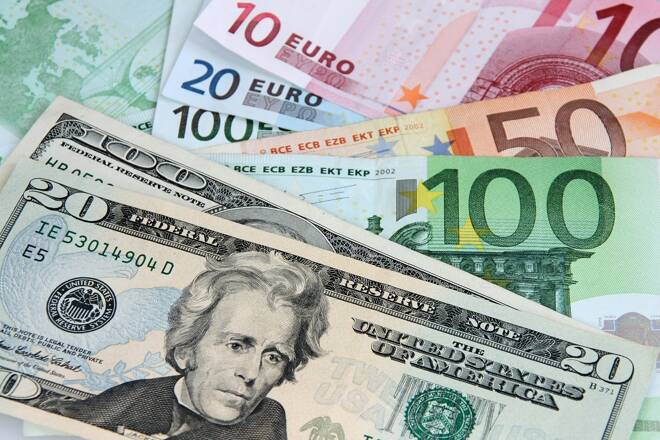Advertisement
Advertisement
EUR/USD Forecast: ECB Signals and Grim Economic Data Clash
By:
With the EUR/USD under pressure, all eyes are on the German and Eurozone inflation figures to gauge the ECB's next move.
Highlights
- The EUR/USD ended the week down 0.68% to $1.07946, revisiting a session low of $1.07659 after striking a high of $1.08417.
- The jury is out post-Jackson Hole Symposium on whether the Fed and ECB will lift rates, putting economic divergence in focus.
- German and Eurozone inflation figures, due Wednesday and Thursday, could shift sentiment toward the ECB interest rate outlook.
Friday Overview
On Friday, the EUR/USD slipped by 0.15%. Following a 0.48% loss on Thursday, the EUR/USD ended the week down 0.68% to $1.07946. The EUR/USD struck a Friday high of $1.08417 before revisiting a session low of $1.07659.
Central Bank Guidance Offsets Grim Economic Indicators
It is a busy week for the EUR/USD, with marquee economic indicators from the euro area in focus. While ECB President Lagarde talked about maintaining restrictive policy for as long as required, euro area economic indicators could test the theory.
Inflation figures for Germany and the Eurozone could prove pivotal this week. However, investors must wait until Wednesday and Thursday for German and Eurozone inflation figures. Softer inflation numbers would question the ECB interest rate outlook.
Until Wednesday, central bank commentary and market risk sentiment will remain the key drivers.
There are no euro area economic indicators to consider or ECB Executive Board members on the calendar to speak today. However, investors should monitor ECB commentary with the media.
Central Bank Forward Guidance Leaves Economic Divergence in Focus
Following the Jackson Hole Symposium, the jury is out on whether the Fed or the ECB will lift rates higher. The prospect of the Fed and the ECB leaving rates unchanged leaves economic divergence in focus.
US economic indicators signaled a hotter-than-expected US economy, supporting the recent EUR/USD losses. However, US economic indicators this week need to send a similar message to avoid a dollar sell-off.
Core PCE Price Index, personal spending, and the US Jobs Report are out on Thursday and Friday. The economic calendar sets the EUR/USD pair up for a volatile second half of the week.
For the Fed, sticky inflation, an uptrend in personal spending, a pickup in wage growth, and a steady unemployment rate would likely give the dollar the upper hand.
Tight labor market conditions continue to fuel wage growth and demand-driven inflationary pressures. Further interest rate hikes would hit disposable incomes and consumption. A pullback in consumption would ease demand-driven inflationary pressures.
Later today, we expect investors to brush aside the Dallas Fed Manufacturing Index numbers. The US manufacturing sector accounts for less than 30% of the US economy, leaving the investor focus on the services sector, labor market conditions, and inflation.
EUR/USD Price Action
Daily Chart
The Daily Chart showed the EUR/USD above the $1.0750 – $1.0700 support band. A bullish start to the week saw the EUR/USD move through the 200-day EMA. However, the EUR/USD remains below the 50-day EMA, sending bearish near-term but bullish longer-term price signals.
Looking at the 14-Daily RSI, the 35.27 reading reflects a bearish sentiment. The RSI and the 50-day EMA signal a fall through the 200-day EMA to bring the upper level of the $1.0750 – 1.0700 support band into view. However, a EUR/USD hold above the 200-day EMA would give the bulls a run at the $1.0850 – $1.0900 resistance band.
4-Hourly Chart
The EUR/USD remains below the $1.0850 – $1.0900 resistance band. Despite the bullish morning, the EUR/USD sits below the 50-day and 200-day EMAs, sending bearish near and longer-term price signals.
The 14-4H RSI at 42.69 reflects a bearish sentiment, with selling pressure outweighing buying pressure. Significantly, the RSI and EMAs signal a fall through the upper level of the $1.0750 – $1.0700 support band. However, a EUR/USD move through the lower level of the $1.0850 – $1.0900 resistance band would give the bulls a run at the 50-day EMA.
About the Author
Bob Masonauthor
With over 28 years of experience in the financial industry, Bob has worked with various global rating agencies and multinational banks. Currently he is covering currencies, commodities, alternative asset classes and global equities, focusing mostly on European and Asian markets.
Did you find this article useful?
Latest news and analysis
Advertisement
